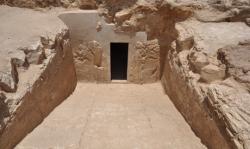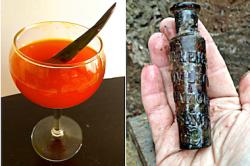INSTITUT SUPERIEUR D'ANTHROPOLOGIE
INSTITUTE OF ANTHROPOLOGY
ONLINE COURSES / COURS A DISTANCE
SUMMER TERM : JULY 2014
REGISTER NOW
VIET NAM – Nam Thanh - The Institute of Archaeology and Ha Giang Province's Museum have uncovered remnants of the 600-year-old Nam Dau Pagoda in Nam Thanh Village, in Vi Xuyen district's Ngoc Linh Commune. Although the major architecture of the pagoda is no longer intact, its vestige and relics bear significant historical and cultural values, greatly contributing to the study of history and culture of the Tran dynasty (1225-1400) in the locality, according to Dr Tran An Dung from the institute. After two months of work, the excavation team discovered many remnants, such as pebbles, roofing tiles, earthenware statues of phoenixes or cranes, and dragon statues fixed on roofs. Dung said many remnants had only been found in Thang Long Imperial Citadel or other essential royal structures. The excavation team also found precious relics, proving the existence of another Tran dynasty's pagoda in Na Lach Village, Linh Ho Commune. The pagoda is assumed to be from the same era, though smaller than Nam Dau Pagoda.
http://vietnamnews.vn/life-style/256215/ancient-pagoda-traces-in-ha-giang.html
EGYPTE –  Assasif - Tomb number TT 209 in Assasif area on Luxor's West Bank was rediscovered yesterday by Spanish excavators The tomb was first discovered in 1904 by Sir Robert Mond, but Mond didn’t describe the tomb's architectural style or identify its occupant. The tomb was then abandoned and became buried beneath the sands. Egyptologists looked for it subsequently, but their efforts failed. "It is a very mysterious tomb," asserted Ibrahim, adding that the name of the tomb had changed several times since being mentioned in A Topographical Catalogue of the Private Tombs of Thebes, by Alan Gardiner and Arthur Weigall, published in 1913. The occupant was first known as “Hatashemro.” Then in the 1950s, he was mentioned as “Seremhatrekhyt.” Later studies revealed that Seremhatrekhyt was a title and not the occupant's name.During the 1980s, the tomb was buried under the sands and not found until the Spanish mission of Laguna University, directed by Miguel Molinero Polo, rediscovered it. Recent preliminary studies show that the tomb dates to the 25th Dynasty and belonged to a person called “As-m-ra Ashemro.” Ibrahim described the rediscovery as being of great importance because it adds a new name to ancient Egyptian history as well as revealing more about the 25th Dynasty. Polo said that ongoing study of the tomb will reveal the different titles of the tomb's occupant as well as a comprehensive plan of the architecture of the tomb.
Assasif - Tomb number TT 209 in Assasif area on Luxor's West Bank was rediscovered yesterday by Spanish excavators The tomb was first discovered in 1904 by Sir Robert Mond, but Mond didn’t describe the tomb's architectural style or identify its occupant. The tomb was then abandoned and became buried beneath the sands. Egyptologists looked for it subsequently, but their efforts failed. "It is a very mysterious tomb," asserted Ibrahim, adding that the name of the tomb had changed several times since being mentioned in A Topographical Catalogue of the Private Tombs of Thebes, by Alan Gardiner and Arthur Weigall, published in 1913. The occupant was first known as “Hatashemro.” Then in the 1950s, he was mentioned as “Seremhatrekhyt.” Later studies revealed that Seremhatrekhyt was a title and not the occupant's name.During the 1980s, the tomb was buried under the sands and not found until the Spanish mission of Laguna University, directed by Miguel Molinero Polo, rediscovered it. Recent preliminary studies show that the tomb dates to the 25th Dynasty and belonged to a person called “As-m-ra Ashemro.” Ibrahim described the rediscovery as being of great importance because it adds a new name to ancient Egyptian history as well as revealing more about the 25th Dynasty. Polo said that ongoing study of the tomb will reveal the different titles of the tomb's occupant as well as a comprehensive plan of the architecture of the tomb.
http://english.ahram.org.eg/NewsContent/9/40/103666/Heritage/Ancient-Egypt/Ancient-Egyptian-tomb-lost-for-decades-rediscovere.aspx
NEPAL –  Tilaurakot - A team of archeologists and experts have started excavation work at Tilaurakot , where Prince Siddhartha is believed to have spent his early life before he became Gautam Buddha.Kunwar said that the Lumbini Development Trust (LDT) is planning to construct various infrastructures in the area for the overall development of tourism in Tilaurakot . They started the fresh excavation to save places of historical and archeological importance before any of that is done. Ten workers including technicians have started the excavation work by digging trenches that are 10 meters wide and 2 meters deep. Earlier, a team of archeologists from the Department of Archeology, the Lumbini Development Trust and experts from the Unesco and UK-based Durham University had excavated the area by taking out soil sample after digging two to three meters deep. The team said that they had found ancient cultural artifacts like mud utensils during the excavation . The city of Tailaurakot had caught the eyes of the archaeologists after a recent geological survey conducted in the area substantiated that there might be remains of an ancient city underneath the ground, prompting the archaeologists to start the excavation .
Tilaurakot - A team of archeologists and experts have started excavation work at Tilaurakot , where Prince Siddhartha is believed to have spent his early life before he became Gautam Buddha.Kunwar said that the Lumbini Development Trust (LDT) is planning to construct various infrastructures in the area for the overall development of tourism in Tilaurakot . They started the fresh excavation to save places of historical and archeological importance before any of that is done. Ten workers including technicians have started the excavation work by digging trenches that are 10 meters wide and 2 meters deep. Earlier, a team of archeologists from the Department of Archeology, the Lumbini Development Trust and experts from the Unesco and UK-based Durham University had excavated the area by taking out soil sample after digging two to three meters deep. The team said that they had found ancient cultural artifacts like mud utensils during the excavation . The city of Tailaurakot had caught the eyes of the archaeologists after a recent geological survey conducted in the area substantiated that there might be remains of an ancient city underneath the ground, prompting the archaeologists to start the excavation .
http://www.ekantipur.com/2014/06/16/national/fresh-excavation-work-begins-at-tilaurakot/390932.html
ROYAUME UNI –  Londres - Le palais de Westminster représente la puissance politique et culturelle de l'Angleterre depuis plus de mille ans. Or, il pourrait très bientôt s'effondrer dans la Tamise, à cause d'une structure usée par le temps. La Baronne de Boothroyd, ancienne présidente de la Chambre des communes, a appelé le gouvernement à réagir de façon efficace, "avant qu'il ne soit trop tard". Des travaux avaient pourtant déjà été entrepris en 2012, mais ils n'avaient pas suffi à combler les dommages. Une demande a été déposée pour que le palais soit ajouté à la liste du patrimoine mondial en péril à l'Unesco. Le palais de Westminster abrite le Parlement anglais, l'église St Margaret, ainsi que l'abbaye de Westminster, où reposent Charles Darwin et nombre de Britanniques célèbres et où se sont mariés en 2011 le prince William et Catherine Middleton. Sa disparition porterait un coup dur au patrimoine anglais et à son siège du pouvoir.
Londres - Le palais de Westminster représente la puissance politique et culturelle de l'Angleterre depuis plus de mille ans. Or, il pourrait très bientôt s'effondrer dans la Tamise, à cause d'une structure usée par le temps. La Baronne de Boothroyd, ancienne présidente de la Chambre des communes, a appelé le gouvernement à réagir de façon efficace, "avant qu'il ne soit trop tard". Des travaux avaient pourtant déjà été entrepris en 2012, mais ils n'avaient pas suffi à combler les dommages. Une demande a été déposée pour que le palais soit ajouté à la liste du patrimoine mondial en péril à l'Unesco. Le palais de Westminster abrite le Parlement anglais, l'église St Margaret, ainsi que l'abbaye de Westminster, où reposent Charles Darwin et nombre de Britanniques célèbres et où se sont mariés en 2011 le prince William et Catherine Middleton. Sa disparition porterait un coup dur au patrimoine anglais et à son siège du pouvoir.
https://fr.news.yahoo.com/grande-bretagne-palais-westminster-pourrait-dispara%C3%AEtre-095700422.html
USA –  New York -Archaeologists have dug up a 19th-century recipe for fending off death. During a recent excavation beneath a hotel site at 50 Bowery, Chrysalis Archaeology discovered a tiny, greenish glass bottle that once contained the "Elixir of Long Life." The bottle found amid a cache of 150-year-old liquor bottles beneath what was once a German beer garden sparked the archaeologists' curiosity, and they decided to hunt down the original recipe so they could try the elixir themselves. They also plan to recreate Dr. Hostetters Stomach Bitters, a once-popular 19th-century medicine, after finding two of those bottles at the 50 Bowery site and seeking out that recipe as well.
New York -Archaeologists have dug up a 19th-century recipe for fending off death. During a recent excavation beneath a hotel site at 50 Bowery, Chrysalis Archaeology discovered a tiny, greenish glass bottle that once contained the "Elixir of Long Life." The bottle found amid a cache of 150-year-old liquor bottles beneath what was once a German beer garden sparked the archaeologists' curiosity, and they decided to hunt down the original recipe so they could try the elixir themselves. They also plan to recreate Dr. Hostetters Stomach Bitters, a once-popular 19th-century medicine, after finding two of those bottles at the 50 Bowery site and seeking out that recipe as well.
http://www.dnainfo.com/new-york/20140616/lower-east-side/archaeologists-recreate-elixir-of-long-life-after-unearthing-1800s-bottle
CANADA –  Pabos - La Corporation du Bourg de Pabos, avec l’appui du Ministère de la Culture et des Communications du Québec, procède encore pour un peu plus d’une semaine à des fouilles pour retrouver des vestiges qui pourraient être menacés.L’ancienne seigneurie du Grand Pabos est au cœur de l’histoire de la Gaspésie et l'on y trouve encore d’importants vestiges archéologiques témoignant de nos origines françaises. Les recherches archéologiques réalisées durant les années 1980 ont permis de recueillir une importante collection d’artéfacts, d’écofacts et de vestiges calcinés confirmant la valeur historique du site classé en 1975. Les fouilles sur l’île Beau Séjour, lieu de résidence des seigneurs De Bellefeuille, ont enrichi la connaissance historique et archéologique de l’un des plus important poste de pêche sédentaire de la Gaspésie sous le Régime français. Malheureusement, les fouilles sont interrompues depuis 1987 et l’érosion de l’île se poursuit malgré les efforts de la Corporation du Bourg de Pabos pour préserver les vestiges qui s’y trouvent.
Pabos - La Corporation du Bourg de Pabos, avec l’appui du Ministère de la Culture et des Communications du Québec, procède encore pour un peu plus d’une semaine à des fouilles pour retrouver des vestiges qui pourraient être menacés.L’ancienne seigneurie du Grand Pabos est au cœur de l’histoire de la Gaspésie et l'on y trouve encore d’importants vestiges archéologiques témoignant de nos origines françaises. Les recherches archéologiques réalisées durant les années 1980 ont permis de recueillir une importante collection d’artéfacts, d’écofacts et de vestiges calcinés confirmant la valeur historique du site classé en 1975. Les fouilles sur l’île Beau Séjour, lieu de résidence des seigneurs De Bellefeuille, ont enrichi la connaissance historique et archéologique de l’un des plus important poste de pêche sédentaire de la Gaspésie sous le Régime français. Malheureusement, les fouilles sont interrompues depuis 1987 et l’érosion de l’île se poursuit malgré les efforts de la Corporation du Bourg de Pabos pour préserver les vestiges qui s’y trouvent.
http://www.lavantage.qc.ca/Actualites/2014-06-15/article-3764437/Fouilles-archeologiques-au-Bourg-de-Pabos-en-Gaspesie/1